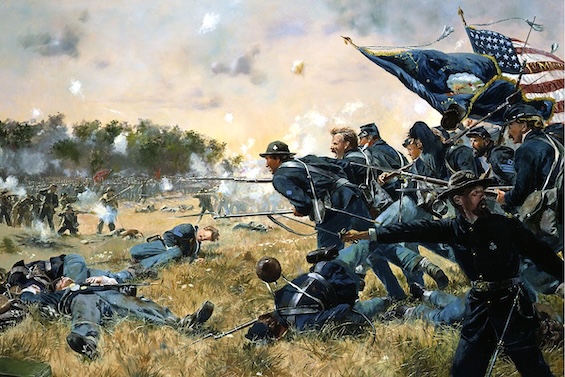The Battle of Gettysburg is the great pivot on which American history turns. At Gettysburg, in July 1863, the Army of the Potomac under George Meade stopped Robert E. Lee’s invasion of the North. If the battle had gone the other way, as it very nearly did, Lee would have marched on some combination of Washington, New York and Philadelphia, England would have recognized the Confederacy, and the Union would likely have had to sue for peace, with disunion the result. While counterfactual history is rarely certain, those things seem highly probable. And it should be remembered that going into the battle, Lee’s Army of Northern Virginia was widely regarded as invincible.
The battle lasted for three days. The decisive day was the second, July 2–162 years ago, today. The second day featured desperate fighting, as time after time the Confederates assaulted Cemetery Ridge, where Meade’s army made its stand. Over the course of the day, Lee’s army concentrated its attacks on the North and South ends of the Union’s position.
General Winfield Scott Hancock, commanding in the center of the Union line, sent troops in both directions throughout the day, reinforcing the areas that were under attack. But late in the afternoon, Scott saw a wave of Confederates crossing the plain between the enemy lines, heading directly for the Union center.
Scott knew that he had only one unit in reserve, and he needed to slow the Confederate advance to buy time to send aides up and down the line to summon more soldiers to man the low stone wall at the top of the ridge. Scott asked the officer in charge, “What unit are you?” “The First Minnesota,” came the answer. “Colonel Colvill commanding.”
The First Minnesota already had a storied history. It was the first unit to sign up when President Lincoln put out a call for volunteers after Fort Sumter. It fought with distinction in one battle after another on the Eastern front. By July 2, 1863, with two companies detached, there were just 262 members of the regiment left. But they were the only men Hancock had, and he gave Colville the order to charge the oncoming Confederates, who outnumbered the Minnesotans by at least five or six to one.
Colville formed up his men and ordered them down the gentle incline, “at the double-quick.” They hit the Confederates so hard that they stopped them in their tracks. Vicious hand-to-hand fighting ensued. Five times, the man who carried the First Minnesota’s colors was shot, and five times another man picked up the standard. The Minnesotans battled the Confederates not just for the five minutes that Hancock calculated he needed, but for fully fifteen.
When the call came to retreat, there were only 47 men left to ascend the hill. They climbed over the stone wall ahead of the onrushing Confederates, but by then Hancock was reinforced, and the Union soldiers easily repulsed the Confederate charge.
It was the most famous suicide charge in the history of the United States Army. Hancock later wrote:
I had no alternative but to order the regiment in. We had no force on hand to meet the sudden emergency. Troops had been ordered up and were coming on the run, but I saw that in some way five minutes must be gained or we were lost. It was fortunate that I found there so grand a body of men as the 1st Minnesota. I knew they must lose heavily and it caused me pain to give the order for them to advance, but I would have done it even if I had known every man would be killed. It was a sacrifice that must be made. The superb gallantry of those men saved our line from being broken.
The First Minnesota ceased to exist as a unit after Gettysburg, as there were so few men left. But their heroism has never been forgotten. Today, if you go to the Minnesota State Capitol in St. Paul, you can see the flag that the First Minnesota carried down the hill at Gettysburg. It is tattered and torn by bullets, but was never captured by the enemy.
We are about to celebrate Independence Day. July 4, 1776, was if course an important day. But I think a case can be made that the most important single day in American history was actually July 2, 1863. There were many heroes on that day–Joshua Lawrence Chamberlain’s 20th Maine regiment, which held Little Round Top against all odds, is justly revered–but the First Minnesota’s suicide charge will always rank at or near the top. So, as you celebrate the Fourth, please take a moment to remember the brave men who made the ultimate sacrifice to give our nation a new birth of freedom.
If you want to learn more about the First Minnesota and its role at Gettysburg, check out John Phelan’s article in Thinking Minnesota.
















